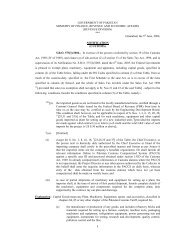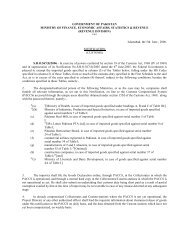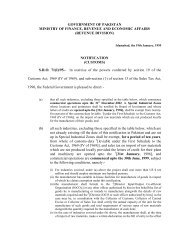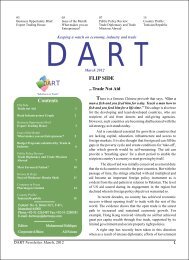47. Pakistan Economic Survey 2011-12 - Consultancy Services in ...
47. Pakistan Economic Survey 2011-12 - Consultancy Services in ...
47. Pakistan Economic Survey 2011-12 - Consultancy Services in ...
You also want an ePaper? Increase the reach of your titles
YUMPU automatically turns print PDFs into web optimized ePapers that Google loves.
<strong>Pakistan</strong> <strong>Economic</strong> <strong>Survey</strong> <strong>2011</strong>-<strong>12</strong>Table <strong>12</strong>.3: Family Plann<strong>in</strong>g Indicators of Regional Countries-<strong>2011</strong>CountryTotal Fertility RateContraceptive PrevalenceRate %Population Growth Rate%India 2.5 56 1.3Maldives 1.7 35 1.3Nepal 2.6 48 1.7Sri Lanka 2.2 68 0.8<strong>Pakistan</strong> 3.4 27 2.03Source: i) State of the world population <strong>2011</strong>, United Nation Fund for Population Activities (UNFPA) PopulationProjection by Plann<strong>in</strong>g Commission’s Work<strong>in</strong>g Group on Population Sector, 2010ii) Sub Group II on Population Projections for the 10 th Five Year People’s Plan 2010-15Table <strong>12</strong>.4: Family Plann<strong>in</strong>g Indicators of Muslim Countries-<strong>2011</strong>Country Total Fertility Rate Contraceptive PrevalenceRate %Population GrowthRate%Egypt 1.7 60 2.6Morocco 2.2 63 1.0Turkey 2.0 73 1.1Iran 1.6 73 1.0Indonesia 2.1 61 1.0Malaysia 2.6 55 1.6<strong>Pakistan</strong> 3.4 27 2.03Source:i) State of the world population <strong>2011</strong>, United Nation Fund for Population Activities (UNFPA) Population Projectionby Plann<strong>in</strong>g Commission’s Work<strong>in</strong>g Group on Population Sector, 2010ii) Sub Group II on Population Projections for the 10 th Five Year People’s Plan 2010-15Fertility <strong>in</strong> <strong>Pakistan</strong>The Total Fertility Rate (TFR) of a population isthe average number of children that are born to awoman over her life time. The TFR is closely tiedto the population growth rates of a country and canbe a good <strong>in</strong>dicator of future population trends.Awareness of contraception is <strong>in</strong>creas<strong>in</strong>g <strong>in</strong> thecountry. Accord<strong>in</strong>g to the Demographic and Health<strong>Survey</strong> of <strong>Pakistan</strong> 2006-07 by the M<strong>in</strong>istry ofPopulation Welfare, 96 percent of women whohave ever been married are aware of at least onefamily plann<strong>in</strong>g method compared to 78 percent <strong>in</strong>1991.The survey also shows that less than 30percent of married women were us<strong>in</strong>gcontraception. The fertility rate per woman hasbeen reduced to 3.4 percent <strong>in</strong> 20<strong>12</strong> from 4.0percent <strong>in</strong> 2006 and the population growth rate hascome down to 2.03 percent.The results are still not encourag<strong>in</strong>g whencompared with other develop<strong>in</strong>g countries of theregion. <strong>Pakistan</strong> has the highest birth as well astotal fertility rate among the Asian develop<strong>in</strong>gcountries. If this trend prevails, it is expected that<strong>Pakistan</strong>’s population will double <strong>in</strong> 2046, andother th<strong>in</strong>gs rema<strong>in</strong><strong>in</strong>g the same <strong>Pakistan</strong>’s rank <strong>in</strong>terms of the selected social and economic<strong>in</strong>dicators <strong>in</strong> comparison with other develop<strong>in</strong>gAsian countries may deteriorate further. Therefore,vigorous efforts are needed to control populationgrowth and reduce the TFR.Fig-<strong>12</strong>.2: Trend <strong>in</strong> Fertility Rate (%)4.54.34.13.93.73.53.33.<strong>12</strong>.92.72.52006 2007 2008 2009 2010 <strong>2011</strong> 20<strong>12</strong>Source: Sub group II on population projection for the10th Five Year People Plan 2010‐15 (Plann<strong>in</strong>g andDevelopment Division)164
















